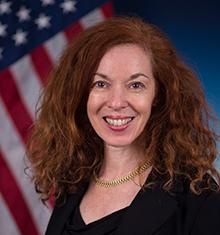CICS Professor Hava Siegelmann Wins Meritorious Public Service Medal from U.S. Department of Defense

Nearly 100 colleagues recently joined an online celebration to honor Professor Hava T. Siegelmann of the University of Massachusetts Amherst's College of Information and Computer Sciences (CICS) as she received the rarely awarded Meritorious Public Service Medal from the Defense Advanced Research Projects Agency (DARPA) of the United States Department of Defense (DoD).
It is the third-highest honor the Department of the Army can bestow on a private citizen. "The distinctive accomplishments of Dr. Siegelmann reflect great credit upon herself, DARPA and the Department of Defense," reads the citation in part.
Siegelmann says, "I didn't know that anyone was noticing what I do. It was so touching, and a complete surprise. I feel honored to be contributing." She adds, "I think UMass should get credit for supporting me to run a very advanced AI lab such that the government wanted to invite me, and for allowing me to join what is literally the world's most advanced and sophisticated AI initiative."
CICS Dean Laura Haas says of the honor, "I am extremely proud of Hava's service to DARPA and the nation. Our college is dedicated to a vision of Computing for the Common Good, and Hava's work at DARPA has helped to advance AI for us all."
Siegelmann went to DARPA as a program manager in July 2016, where her charge included "that the United States needs to stay on top in AI," she recalls.
Her citation says, "She created and managed some of DARPA's largest and most advanced AI programs including L2M - developing next-generation advanced AI systems capable of learning in real time and applying learning to environments and circumstances not specifically trained for." Siegelmann, whose career is characterized by thinking outside the box, created a different atmosphere for the L2M project than is usual at DARPA. With its support, she insisted that the large, diverse teams of scientists she chose from the nation's top university and industry research organizations must actively collaborate. She says, "Such a large leap in AI technology can only be achieved when we top researchers all put our strengths together and learn from each other."
The medal cites another major DARPA program Siegelmann created called GARD - Guaranteeing AI Robustness against Deception. It is "to establish the theoretical machine learning system vulnerabilities, characterize properties that will enhance system robustness and encourage the creation of effective defenses." As systems become more advanced, these advancements open new avenues by which they can be attacked. GARD identifies often obscure, technically complex vulnerabilities and builds new-generation defenses for them, she adds.
DARPA also points out that Siegelmann's "exceptionally productive" term included developing a system that administers insulin plus dextrose to maintain glucose at safe levels for patients in critical care and those with diabetes; sensors to identify dangerous chemicals from a safe distance; collaborative, secure learning systems that allow group collaboration without revealing sensitive data; and methods to identify attacks by reverse engineering to secure the system and find the attacker.
Siegelmann says, "L2M has had major success in creating systems capable of learning and improving in real time." Current AI systems use, in DARPA terminology, both first and second generation AI. In the first, to create medical expert systems of the 1980s, for example, she says, "The system attempts to imitate the way an 'expert' thinks or approaches a task through coding. In the 1990s, second generation neural network-based machine learning matured and outperformed first-gen systems." This means that instead of coding information as before, the process adds a 'learning/training algorithm. The network then trains repeatedly on a large set of examples and creates its own responses.
Today's AI, a combination of the two generations, works very well in relatively static environments, but when embedded in real-world systems, where changing conditions are the norm, "the AI fails when it encounters conditions outside its training. To correct for failures, the network must be taken out of service and go through a lengthy retraining process," she notes.
New L2M systems being developed through her DARPA program represent "a fundamental change in machine learning," Siegelmann says. L2M systems can successfully apply experience and adapt lessons learned to new data or situations. "Self-driving cars, for instance, represent the current pinnacle of AI systems. All major auto-driving vehicle systems rely on extremely sophisticated first and second generation AI, and demonstrate how far this technology can take us using increasingly clever programming, and an ever-growing collection of data incorporated into the training set."
In this way, L2M systems actually become better the more they experience, so an L2M system becomes ever safer driving in icy conditions each time it encounters them, she adds. But, "it is very hard for a machine to learn actively; there is still much to be done."
The AI expert says, "We made a huge amount of progress, demonstrated actual learning - something never done before, and we set the foundation for the next generation of expert, autonomous systems." Some L2M improvements are now being incorporated into real-world systems, she says, so in five years, AI systems will mainly be the L2M variety.
Overall, "DARPA was a wonderful, highly productive experience," Siegelmann says. "I can't say enough about my DARPA colleagues and the truly bright and far-seeing researchers I worked with. My goal now is to continue my research - advancing AI learning and, equally as important, to start teaching the next generation of computer scientists, giving them the new skills they'll need, skills not yet taught in current AI programs, to create and advance the systems that will increasingly be part of our infrastructure."